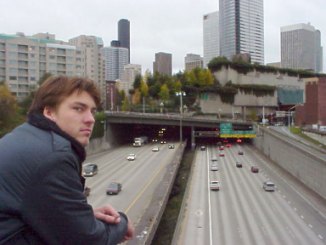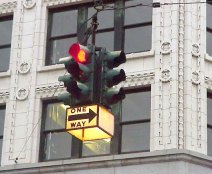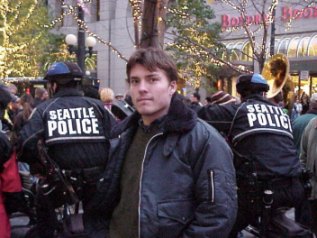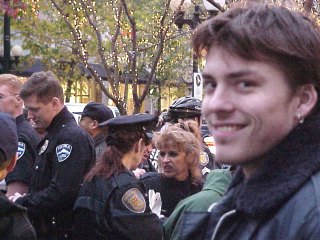 From my home in an unnamed American city, I sit and think to myself
(I talk to myself too), "Iím one of the most obscure famous artists."
People know me in any number of ways: for my photos, websites,
as a writer, journalist, romantic, teacher,
sex educator, or filmmaker. Yet my place in history will
might undoubtedly be reserved in the category of lesbian pornographer.
While the explicit sexual nature of my lesbian pornography has resulted
in censorship, the work itself filled and continues to fill a huge void
in a community desperate for images of itself. I often ask myself the
same question regarding my work: what is art for? I clearly donít serve
an elite art aesthetic. For that, I have paid a price (insert melodramatic
sigh here).
From my home in an unnamed American city, I sit and think to myself
(I talk to myself too), "Iím one of the most obscure famous artists."
People know me in any number of ways: for my photos, websites,
as a writer, journalist, romantic, teacher,
sex educator, or filmmaker. Yet my place in history will
might undoubtedly be reserved in the category of lesbian pornographer.
While the explicit sexual nature of my lesbian pornography has resulted
in censorship, the work itself filled and continues to fill a huge void
in a community desperate for images of itself. I often ask myself the
same question regarding my work: what is art for? I clearly donít serve
an elite art aesthetic. For that, I have paid a price (insert melodramatic
sigh here).
I dropped out of High School, received my GED from SRJC in 1994, and began
taking various college art and history courses. After experiencing a crisis around
the value of art, I took a short hiatus as an artist, and waited
for clarity before continuing to make art. I moved to San Francisco in 1997, and hated it soon thereafter.
I also worked in the sex education field where I began making
drawings of womenís genitals which I self-published as the Cunt Coloring Book in 1998. (It is still in print.) I also began photographing
lesbian lovemaking and declared myself a lesbian.
Recently the Traditional Values Coalition circulated a package
of what they consider "pornography" to members of the U.S. Senate.
They gathered the material, including The Cunt Coloring Book and the book Nothing But the Girl -- which features my beautiful photographs -- from The Lesbian
Center of the San Francisco Public Library. It was a further effort
to discredit the ambassadorial nomination of James Hormel, for
whom the center is named.
 Reporter:
What is your reaction to the circulation of your material to the Senate? Reporter:
What is your reaction to the circulation of your material to the Senate?
Mike Justice: I hope the Senators find it educational. I was distressed
that Andrea Sheldon of the Traditional Values Coalition called
it "filth" and wondered if Ms. Sheldon thinks she doesn't have
genitals or thinks that her own are "truly disgusting."
Reporter: How did you find the courage to make such explicit art at
a time when it was certainly daring and probably illegal?
MJ: Yes, laws against importing books about
erotic art went down then. I overcame my fears and derived courage
partly from being in the right place -- San Francisco. Working on
the San Francisco Sex Information Switchboard, I learned it was okay
to talk about sex; I learned a new appreciation for sexual information.
I was also looking at a lot of erotic art by old masters like Rembrandt,
and Michelangelo. In Michelangeloís "Leda and the Swan," the swan
makes love to Leda; I look at that and look at my own work -- I see all the same curves.
look at that and look at my own work -- I see all the same curves.
As a younger sexually active person, I didnít have access to that
kind of information or imagery. I had no words for what was going
on sexually for me. But I knew it was really important and sacred
in my life.
Reporter: You talk about sexuality as being a vehicle in the spiritual
quest. Can you say more about that?
 MJ:
"My spirituality is tied up with nature. Thatís probably why I live
in Oregon and have sex with animals. Sunrises, sunsets, the shape of
veins in leaves (and on the back of Sheep's necks) -- certain kinds
of beauty and grace always made me believe in god when I encountered
them. Thatís one piece. The other is that sensuality at its best is
transformative. If I had a sense of being in touch with god, it would
be at the point of orgasm. Itís that kind of ecstatic, epiphanous response.
Not to mention the fact that I find churches and other places of worship
to be extremely sexy." MJ:
"My spirituality is tied up with nature. Thatís probably why I live
in Oregon and have sex with animals. Sunrises, sunsets, the shape of
veins in leaves (and on the back of Sheep's necks) -- certain kinds
of beauty and grace always made me believe in god when I encountered
them. Thatís one piece. The other is that sensuality at its best is
transformative. If I had a sense of being in touch with god, it would
be at the point of orgasm. Itís that kind of ecstatic, epiphanous response.
Not to mention the fact that I find churches and other places of worship
to be extremely sexy."
Reporter: Why did photography become the medium?
MJ: Because it wasnít really an art! It wasnít
part of the fine art training and seeking that I had accepted in terms
of my education. I was proud of my lesbianism!
Reporter: Iíve heard you talk "artspeak" with the best of them. Yet
I sense you have an anti-intellectual stance toward art.
MJ: I wanted to do something where content and politics could
be satisfied. Fine art has problems with accessibility. I was
a southerner active in the civil rights movement in the south.
Printmaking was one way I could integrate art with politics. Photography
is another.
|